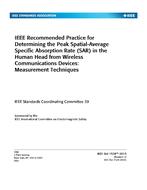
Click here to purchase
Revision Standard – Active.Protocols and test procedures are specified for the measurement of the peak spatial-average SAR induced inside a simplified model of the head of users of certain handheld radio transceivers. These transceivers are intended to be used for personal wireless communications services, operate in the 300 MHz to 6 GHz frequency range, and are intended to be operated while held against the ear. The results obtained by following the protocols specified in this recommended practice represent a conservative estimate of the peak spatial-average SAR induced in the head of a significant majority of persons, subject to measurement and other uncertainties that are defined in this recommended practice. The results are representative of those expected during conditions of intended use of a handheld wireless device. It is not the intent of this recommended practice to provide a result representative of the absolute maximum SAR value possible under every conceivable combination of head size, head shape, handset orientation, and spacing relative to the head. The measurement of SAR induced in the external tissues of the head, e.g., the external ear (pinna), is not addressed in this document. This recommended practice also does not address the body SAR measurements typically required for wireless handsets. The following items are described in detail: measurement concepts, measurement techniques, instruments, calibration techniques, simulated-tissue (phantom) models, including homogeneous anatomically equivalent models of the human head and simple phantoms for validation of the SAR measurement system, and the limitations of these systems when used for measuring the spatial-peak mass-averaged SAR. Procedures for calibrating electric field (E-field) probes used for SAR measurements and assessing the SAR measurementand system uncertainties are provided in the annexes. This recommended practice is intended primarily for use by engineers and other specialists who are familiar with electromagnetic (EM) theory and SAR measurement techniques; it does not recommend specific SAR limit values since these are found in other documents. The benefits to the users include standardized and accepted protocols, validation techniques, and means for estimating the overall measurement uncertainty in order to produce valid and repeatable data.
Product Details
- Published:
- 09/06/2013
- ISBN(s):
- 9780738189154, 9780738189161, 9781504415422, 9780738185262, 9780738185279
- Number of Pages:
- 246
- File Size:
- 1 file , 5 MB
- Redline File Size:
- 2 files , 10 MB
- Product Code(s):
- STD98305, STDRL98305, STDPD98305, STDPDRL98305, STDPL98305